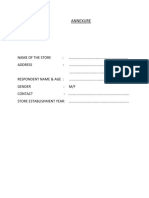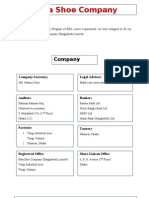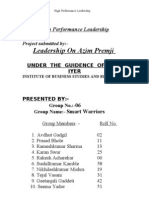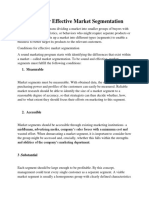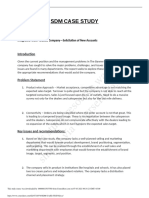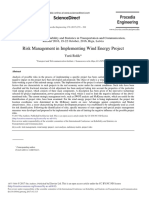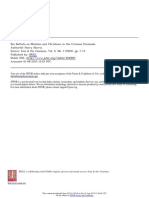0 ratings0% found this document useful (0 votes)
783 viewsIndustry Analysis
Industry Analysis
Uploaded by
Labarinto Eron JohnThe document discusses the shoe industry. It notes that the industry includes manufacturers, wholesalers, and retailers. Major wholesalers own brands and source from independent manufacturers, while retailers range from large chains to small local stores. The industry is mature overall but new companies can succeed with popular new designs. Athletic shoes account for 30% of sales, dominated by Nike and Adidas, while other categories are more fragmented. Innovation and meeting fashion trends is important for success. Key metrics include comparable store sales and inventory levels.
Copyright:
© All Rights Reserved
Available Formats
Download as DOCX, PDF, TXT or read online from Scribd
Industry Analysis
Industry Analysis
Uploaded by
Labarinto Eron John0 ratings0% found this document useful (0 votes)
783 views7 pagesThe document discusses the shoe industry. It notes that the industry includes manufacturers, wholesalers, and retailers. Major wholesalers own brands and source from independent manufacturers, while retailers range from large chains to small local stores. The industry is mature overall but new companies can succeed with popular new designs. Athletic shoes account for 30% of sales, dominated by Nike and Adidas, while other categories are more fragmented. Innovation and meeting fashion trends is important for success. Key metrics include comparable store sales and inventory levels.
Original Description:
footwear industry
Copyright
© © All Rights Reserved
Available Formats
DOCX, PDF, TXT or read online from Scribd
Share this document
Did you find this document useful?
Is this content inappropriate?
The document discusses the shoe industry. It notes that the industry includes manufacturers, wholesalers, and retailers. Major wholesalers own brands and source from independent manufacturers, while retailers range from large chains to small local stores. The industry is mature overall but new companies can succeed with popular new designs. Athletic shoes account for 30% of sales, dominated by Nike and Adidas, while other categories are more fragmented. Innovation and meeting fashion trends is important for success. Key metrics include comparable store sales and inventory levels.
Copyright:
© All Rights Reserved
Available Formats
Download as DOCX, PDF, TXT or read online from Scribd
Download as docx, pdf, or txt
0 ratings0% found this document useful (0 votes)
783 views7 pagesIndustry Analysis
Industry Analysis
Uploaded by
Labarinto Eron JohnThe document discusses the shoe industry. It notes that the industry includes manufacturers, wholesalers, and retailers. Major wholesalers own brands and source from independent manufacturers, while retailers range from large chains to small local stores. The industry is mature overall but new companies can succeed with popular new designs. Athletic shoes account for 30% of sales, dominated by Nike and Adidas, while other categories are more fragmented. Innovation and meeting fashion trends is important for success. Key metrics include comparable store sales and inventory levels.
Copyright:
© All Rights Reserved
Available Formats
Download as DOCX, PDF, TXT or read online from Scribd
Download as docx, pdf, or txt
You are on page 1of 7
1
Labarinto, Eron John D.
BSBA-MM 4-3N
Industry Analysis: Shoe
The Shoe Industry consists of a multitude of footwear
manufacturers, wholesalers, and retailers. The major
wholesalers in the U.S. market are owners of a brand name and
typically source their shoes from independent manufacturers.
The retail segment of the industry ranges from owners of large
multinational chains to small local businesses. Many shoe
companies operate in both the retail and wholesale arenas. Shoe companies covered by Value
Line generally adhere to the standard industrial page format.
Competitive Landscape
Taken as a whole, the Shoe Industry could be described as mature. However, barriers to entry are
far from insurmountable. Since demand is largely driven by fashion and demographics,
newcomers with a hot product may thrive at the expense of a fading rival. Indeed, the
profitability of individual companies depends on their ability to design attractive footwear lines
and remain at the forefront of consumers' consciousness.
There are three major product categories within the Shoe Industry and the dynamics of each may
differ. The athletic shoe segment, which makes up about 30% of footwear sales, is highly
concentrated, as the largest companies comprise a vast majority of the market share. Two players
(Nike and adidas) dominate this category, with the giants slugging it out over sponsorship
2
contracts with star athletes and snuffing out the competition using their economies of scale in
distribution and marketing. Men's and women's casual and dress shoes make up about 40% of the
market (15% men's and 25% women's, respectively). The companies within these categories tend
to be smaller than their athletic counterparts and compete on the basis of superior design. Thus,
the market for men's and women's shoes is much more fragmented, consisting of a myriad of bit
players. Women's shoemakers, in particular, must be lean and flexible to meet the changing
tastes of their consumers. Demand here can be fairly cyclical, but the ebb and flow of
performance can be attributed more to the individual product portfolio rather than
macroeconomic factors. The economy does play a role in demand, though, particularly for
products that are more up-market. The remaining 30% is comprised of various niche product
categories and boom-or-bust novelty designs.
Product Innovation
Due to rapidly changing tastes of shoe buyers, it is important for shoemakers to continually offer
better and bolder product lines to catch the consumer's eye. For the athletic shoe companies, this
largely means improving comfort and performance. In the dress and casual markets, it means
offering smart, fashion-forward designs. Superior products also command higher price points,
improving profitability. That said, the worst thing a company in the shoe industry can do is
expect to coast by on the back of a few successful product offerings as the rest of the market
passes it by. Even though this can lead to great short-term growth, it is not a recipe for long-term
sustainability. The success of a company's product offerings can generally be gauged by the
following performance metrics.
Important Metrics
3
For shoe retailers, comparable-store sales is a key measure of revenue performance. Although
this statistic is not displayed as part of our numerical presentation on the Value Line page, it is
often referenced by analysts within the stock commentary. This metric measures top-line growth
at the existing store base over a set period of time, usually on a quarterly or yearly basis, rather
than including newly opened locations. Healthy same-store sales gains indicate that the retailer is
successfully stocking desirable products and provides meaningful insight into future earnings
performance. Although retailers face high fixed costs related to rents and inventory, strong
comparable-store sales growth will dilute the impact of these expenses and improve operating
leverage.
Inventory levels are also of particular concern. Inventory growth is positive, if it is paired with an
increased market presence. However, it may mean a sharp decline in profitability is at hand,
absent a corresponding rise in the store count/distribution footprint. Retailers that misread market
dynamics and order excess product often face the prospect of deep discounts, depleting profits.
The same can be said of wholesalers that overproduce footwear without a corresponding retail
market.
Investors in these stocks should focus on companies with healthy growth and a lean cost
structure. Efficient inventory management is of the utmost importance, as fashion trends may
change seemingly overnight. For retailers, this means maintaining a pulse on consumer demand
and achieving economies of scale in procurement and marketing functions. Within the
wholesaling segment, this means strong supply chain management coupled with an increasing
distribution footprint. This type of flexible structure enables a shoemaker to adapt to changing
trends and come out a relative winner no matter what the economic environment.
4
Concluding Considerations
Companies within the Shoe Industry are impacted by a variety of factors, from the
macroeconomic environment to fashion trends within particular footwear categories. That said,
investors should pay close attention to same-store sales and margin trends, as well as inventory
management. The companies that succeed in these areas tend to be the best run and, thus, are
more likely to stay ahead of fashion trends and remain competitive in the marketplace. Strong
brand recognition is another factor to take into consideration, as these names are more likely to
resonate with consumers when faced with similar product offerings.
17%
13%
10%
20%
9%
6%
25%
Shoe Category Market Share
Womens casual shoes
Womens dress shoes
Womens athletic shoes
Mens athletic shoes
Mens casual shoes
Mens dress shoes
Other styles
5
Top Ten Footwear Consumption Countries
In Europe, the footwear industry has declined in the last years. While in 2005, there were about
27.000 firms, in 2008 there were only 24.000. As well as the number of firms, the direct
employment has decreased. The only factors that remained almost steady was the value added at
factor cost and production value.
In the U.S., the annual footwear industry revenue was $48 billion in 2012. There are about
29.000 shoe stores in the U.S. and the shoe industry employs about 189.000 people.Due to rising
imports, these numbers are also declining. The only way of staying afloat in the shoe market is to
establish a presence in niche markets.
Footwear Market Global Industry Size, Market Share, Trends, Analysis, and Forecast,
2012 - 2018: Transparency Market Research
According to a new market report published by Transparency Market Research Footwear
Market Global Industry Size, Market Share, Trends, Analysis, and Forecast, 2012 - 2018, the
6
global footwear market was worth USD 185.2 billion in 2011 and is expected to reach USD
211.5 billion in 2018, growing at a CAGR of 1.9% from 2011 to 2018. In the overall global
market, Asia Pacific is expected to maintain its lead position in terms of revenue till 2018. Asia
Pacific is expected to enjoy 30.1% of the global footwear market revenue share in 2018 followed
by Europe.
The global footwear market is experiencing a stable growth rate due to changing fashion trends.
This market has exhibited sustainable development owing to driving factors such as rising
demand for innovative designs, growing awareness about healthy and active lifestyle, rising
population and disposable income levels, and rise in retail culture.
The athletic footwear market is expected to grow at a CAGR of 1.8% from 2011 to 2018 to reach
USD 84.4 billion by 2018. Non-athletic footwear is the largest market segment and is expected
to grow at a faster CAGR as compared to the athletic footwear segment. Various fashion trends
in the market such as demand for innovative designs and styles, and celebrity endorsement is
driving the non-athletic footwear market.The global footwear market is segmented into Men,
Women and Kids footwear. Mens footwear market is a leading segment with 52% market share
of the overall footwear market. Kids footwear market is expected to grow at a CAGR of 3.7%
due to the high demand of comfortable and designer footwear for kids.
.
Based on type of distribution, footwear retailing is sub-divided into store-based and non-store
retailing. Store-based footwear retailing accounted for most of the footwear market revenue and
is valued at USD 173.6 billion in 2011. Non-store footwear retailing is expected to gain pace in
future and is expected to grow at a CAGR of 6.9% from 2011 to 2018 to reach USD 18,588
7
million by 2018.The Asia Pacific region holds the largest share at 42% of the overall footwear
market and is expected to grow at a CAGR of 2.1% from 2011 to 2018 followed by Europe with
21% of market share. The Asia Pacific region remains the point of focus for footwear
manufacturers due to the cheaper cost of manufacturing and faster growth in population and
disposable income of consumer groups.
Nike is the world leader in athletic and non-athletic footwear segment and comprehensively
leads the overall global footwear market. The footwear market is largely consolidated with top
five players including Nike, Adidas, Reebok, Puma and New Balance holding around 70%
market share. Other major players in the footwear market are Asics, Converse, Sketchers and K-
Swiss. The popularity of local manufacturers and growing piracy in developing countries
remains the major challenge for global footwear manufacturers.
REFERRENCES:
http://www.valueline.com/Stocks/Industries/Industry_Analysis__Shoe.aspx
http://www.statisticbrain.com/footwear-industry-statistics/
http://www.slideshare.net/annavarghese1485/analysis-on-shoe-industry-based-on-porters-5-force
http://www.prweb.com/releases/2013/9/prweb11094057.htm
http://en.wikipedia.org/wiki/Footwear
You might also like
- Porsche 993 Workshop ManualsDocument20 pagesPorsche 993 Workshop Manualsmarilyn100% (64)
- Literature Review On Advertising and Sales PromotionDocument8 pagesLiterature Review On Advertising and Sales PromotioneldcahvkgNo ratings yet
- PWC Winning in India Retail SectorDocument60 pagesPWC Winning in India Retail SectorsandipgargNo ratings yet
- Annexure 2 PDFDocument7 pagesAnnexure 2 PDFHarishNo ratings yet
- RM Pepsi CoDocument41 pagesRM Pepsi CoVivek BanerjeeNo ratings yet
- Itc Limited: Is The Corporate Governance Only Skin Deep?Document2 pagesItc Limited: Is The Corporate Governance Only Skin Deep?vidhiNo ratings yet
- Size of Industrial Units in IndiaDocument19 pagesSize of Industrial Units in IndianeetikaNo ratings yet
- Product Mix of PumaDocument5 pagesProduct Mix of PumaMarian Shien Angel Palingcod100% (1)
- Summary Limitation of StudyDocument3 pagesSummary Limitation of StudyAnonymous afypKmbEyNo ratings yet
- Aditya Birla Fashion - Motilal Oswal - AR AnalysisDocument24 pagesAditya Birla Fashion - Motilal Oswal - AR Analysisvipul sharmaNo ratings yet
- Study of Effective Brand Management at Edainfront Solutions PVT LTD"Document48 pagesStudy of Effective Brand Management at Edainfront Solutions PVT LTD"neekuj malik100% (1)
- Questionnaire - RetailDocument11 pagesQuestionnaire - RetailNikhil MallviyaNo ratings yet
- TQM in Xerox CoDocument11 pagesTQM in Xerox Corakshith_kota100% (1)
- BMDocument11 pagesBMprasru 37No ratings yet
- Jaipuria Institute of Management 2Document73 pagesJaipuria Institute of Management 2Love JennyNo ratings yet
- A Study On Employee Engagement in Mobis India Limited, ChennaiDocument8 pagesA Study On Employee Engagement in Mobis India Limited, ChennaiGaneshkumar SunderajooNo ratings yet
- SWOT Analysis of IT and ITES Sector: StrengthsDocument3 pagesSWOT Analysis of IT and ITES Sector: StrengthsRahul MahajanNo ratings yet
- P&G - Colgate Final 1Document21 pagesP&G - Colgate Final 1Payal PatelNo ratings yet
- Business EconomicsDocument7 pagesBusiness EconomicsRejith Chandran100% (1)
- Asian PaintsDocument23 pagesAsian PaintsAnkit Thatai100% (1)
- Summer Training ReportDocument44 pagesSummer Training Reportyash choudharyNo ratings yet
- Inder PPT FinalDocument38 pagesInder PPT FinalInderjeet Singh ToorNo ratings yet
- The Retailer's Awareness and Perception About SVS Product in MaduraiDocument48 pagesThe Retailer's Awareness and Perception About SVS Product in MaduraiThangahaiga100% (1)
- Caparo IndiaDocument21 pagesCaparo IndiaSuriNo ratings yet
- LG and Its CompetitorsDocument50 pagesLG and Its CompetitorsBillGates BNo ratings yet
- Product and Marketing Strategy of HMTDocument25 pagesProduct and Marketing Strategy of HMTprateek50% (2)
- Report On Motivation With Reference To J K TyreDocument89 pagesReport On Motivation With Reference To J K TyreChandan ArmorNo ratings yet
- AmazonDocument8 pagesAmazonKlaudia KałużnaNo ratings yet
- Porter's Five Forces Analysis For Indian Automotive IndustryDocument3 pagesPorter's Five Forces Analysis For Indian Automotive IndustryAditya JainNo ratings yet
- Consumer Behaviour Regarding Various Branded ShoesDocument52 pagesConsumer Behaviour Regarding Various Branded ShoesAditi HiraveNo ratings yet
- MA Final Report PDFDocument17 pagesMA Final Report PDFSazid HassanNo ratings yet
- Sharekhan PatternDocument136 pagesSharekhan Patternjrajnikant28yahoocom100% (4)
- What Is The FMCG IndustryDocument4 pagesWhat Is The FMCG IndustryBraham GairolaNo ratings yet
- Hindustan Unilever Sales OrganizationstructureDocument5 pagesHindustan Unilever Sales Organizationstructuresharma_140425015No ratings yet
- Consumer Preference About Different Branded Sports ShoesDocument52 pagesConsumer Preference About Different Branded Sports ShoesAmit SinghNo ratings yet
- Easy Day ReportDocument38 pagesEasy Day ReportNaman Rastogi60% (5)
- Bata Final AssignmentDocument17 pagesBata Final Assignmenttanveerahmed05324420% (1)
- Customer SatisficationDocument20 pagesCustomer Satisficationss_1601100% (1)
- A Study On Financial Performance Analysis of Textile Industries in IndiaDocument5 pagesA Study On Financial Performance Analysis of Textile Industries in Indiamohan ksNo ratings yet
- Balaji Dora Plasticsfinal PrintoutDocument67 pagesBalaji Dora Plasticsfinal PrintoutMichael WellsNo ratings yet
- PatanjaliDocument4 pagesPatanjaliSweta SinghNo ratings yet
- NilgirisDocument105 pagesNilgirisAkila Krishnan50% (2)
- Azim PremjiDocument51 pagesAzim Premjivsb2121987100% (1)
- 7ps of Service MarketingDocument68 pages7ps of Service MarketingvaibhavNo ratings yet
- Assignment 2 Aim: To Prepare Case Study of Visual Merchandising of A Selected Product/brand ShowroomDocument7 pagesAssignment 2 Aim: To Prepare Case Study of Visual Merchandising of A Selected Product/brand ShowroomMahima AgarwalNo ratings yet
- CRM AssignDocument26 pagesCRM AssignDevina GuptaNo ratings yet
- Shoppers Stop FOM ASSIGNMENTDocument15 pagesShoppers Stop FOM ASSIGNMENTPuneet Singh DhaniNo ratings yet
- Harshit J Mistry PPT of MRFDocument11 pagesHarshit J Mistry PPT of MRFHARSHIT MISTRYNo ratings yet
- Organistion Study MRFDocument81 pagesOrganistion Study MRFAkhil ThomasNo ratings yet
- Leshark Global LLP - InternshipDocument38 pagesLeshark Global LLP - InternshipSowmya LakshmiNo ratings yet
- Alok IndustriesDocument61 pagesAlok IndustriesNeel DesaiNo ratings yet
- AcknowledgementDocument7 pagesAcknowledgementasmshihabNo ratings yet
- Bba Nep Syllabus MjpruDocument36 pagesBba Nep Syllabus MjpruRUBA NASIMNo ratings yet
- Conditions For Effective Market SegmentationDocument2 pagesConditions For Effective Market SegmentationBen MathewsNo ratings yet
- 3C Report ON IDBI FEDDERALDocument10 pages3C Report ON IDBI FEDDERALAbhilash SahuNo ratings yet
- SDM Case StudyDocument3 pagesSDM Case StudyShilpi Randhar100% (1)
- Indian TerrainDocument42 pagesIndian TerrainPayal ParidaNo ratings yet
- Green Products A Complete Guide - 2020 EditionFrom EverandGreen Products A Complete Guide - 2020 EditionRating: 5 out of 5 stars5/5 (1)
- BATADocument33 pagesBATACHANDAN CHANDUNo ratings yet
- Footware Market18Document9 pagesFootware Market18Vartika VermaNo ratings yet
- Stepping Into A Bigger, Better Future: A Report On India's Footwear MarketDocument8 pagesStepping Into A Bigger, Better Future: A Report On India's Footwear MarketKomal AroraNo ratings yet
- Sai Sheet MusicDocument160 pagesSai Sheet MusicSai ChNo ratings yet
- nhi túDocument11 pagesnhi túMỹ HạnhNo ratings yet
- Copia de Art History Thesis - by SlidesgoDocument89 pagesCopia de Art History Thesis - by SlidesgoSOFIA ASTRID LINO GONZALEZNo ratings yet
- The Sources of The Indian Constitution: 1. United States of AmericaDocument4 pagesThe Sources of The Indian Constitution: 1. United States of AmericaSakshamNo ratings yet
- Public Accounting ProfessionDocument31 pagesPublic Accounting Professionshyrah1rose1dingalanNo ratings yet
- Classroom Management Final DraftDocument9 pagesClassroom Management Final Draftapi-720402603No ratings yet
- اوراق مواد امريكاDocument2 pagesاوراق مواد امريكاsadallah71No ratings yet
- Computer System Expansion SlotsDocument5 pagesComputer System Expansion SlotsMary Millare100% (1)
- Gastrointestinal & NutritionBlock2 PDFDocument183 pagesGastrointestinal & NutritionBlock2 PDFTed DoyleNo ratings yet
- Times Leader 09-02-2012Document75 pagesTimes Leader 09-02-2012The Times LeaderNo ratings yet
- Serrano V PaglinawanDocument2 pagesSerrano V PaglinawanHermogenes AmorinNo ratings yet
- 1 - Risk Wind EnergyDocument11 pages1 - Risk Wind EnergyBellaNo ratings yet
- HRM Final ReportDocument14 pagesHRM Final ReportSohail AyubNo ratings yet
- FE TONER - The-Carbon-Footprint-Of-Remanufactured-Versus-New-Mono-Toner-Printer-CartridgesDocument5 pagesFE TONER - The-Carbon-Footprint-Of-Remanufactured-Versus-New-Mono-Toner-Printer-CartridgesFátima CarredanoNo ratings yet
- Lecture Notes - Evs Unit - 4Document13 pagesLecture Notes - Evs Unit - 4Nambi Rajan100% (2)
- Joint Memorandum Circular No. - DateDocument24 pagesJoint Memorandum Circular No. - DateNikki MarionNo ratings yet
- Grade 7 10 ScienceDocument22 pagesGrade 7 10 Scienceaila nikka prietosNo ratings yet
- EntrepreneurDocument11 pagesEntrepreneurBasketball mixNo ratings yet
- GPS Tracker and Fuel Sensor Installation Steps 1.2-1Document2 pagesGPS Tracker and Fuel Sensor Installation Steps 1.2-1Marcel HabaNo ratings yet
- Turner V MorganDocument2 pagesTurner V MorganAarav RamcharitarNo ratings yet
- Filipino First PolicyDocument3 pagesFilipino First PolicyEileen Eika Dela Cruz-LeeNo ratings yet
- TICOM Vol. 5 - German AF Sigint ServiceDocument144 pagesTICOM Vol. 5 - German AF Sigint ServiceRobert Vale50% (2)
- Dywidag Approval Z 20.1 106 Gewi Soil Nail EngDocument26 pagesDywidag Approval Z 20.1 106 Gewi Soil Nail Engmarcos ishiyamaNo ratings yet
- Revelation 16:18 We: AdvertisementDocument8 pagesRevelation 16:18 We: AdvertisementrandyNo ratings yet
- Introduction To The Philosophy of Human Person Module 6-Week 6Document8 pagesIntroduction To The Philosophy of Human Person Module 6-Week 6Mariel Lopez - Madrideo100% (1)
- Cotton Rugs CollectionDocument26 pagesCotton Rugs CollectionTausifNo ratings yet
- Norris (Harry) - Ibn Battuta On Muslims and Christians in The Crimean Peninsula (Iran & The Caucasus 8:1, 2004, 7-14)Document9 pagesNorris (Harry) - Ibn Battuta On Muslims and Christians in The Crimean Peninsula (Iran & The Caucasus 8:1, 2004, 7-14)juanpedromolNo ratings yet
- Option Chain Analysis With Examples - Dot Net TutorialsDocument9 pagesOption Chain Analysis With Examples - Dot Net TutorialsMandi100% (3)
- Liberty Union Vs Liberty CottonDocument2 pagesLiberty Union Vs Liberty Cottonrubbtuna100% (1)



